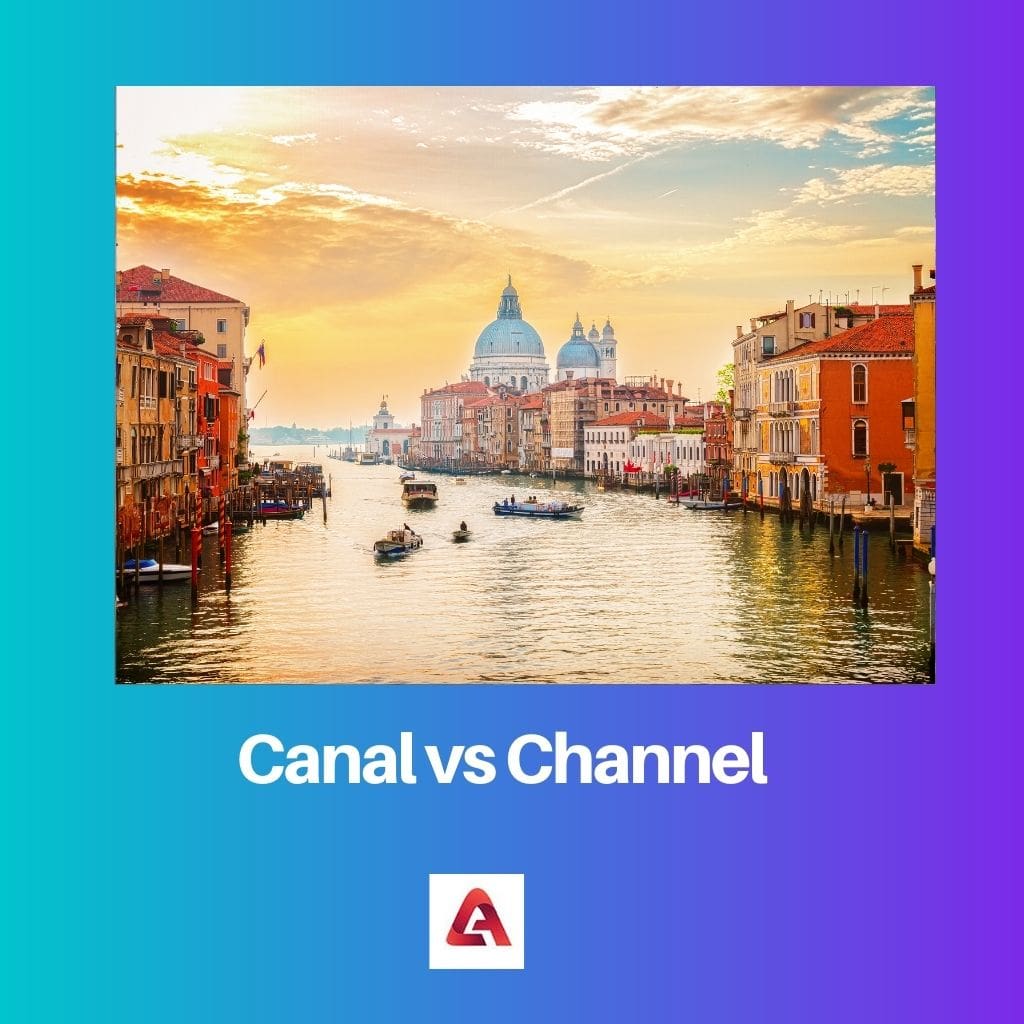The terms canal and channel both relate to waterways. Although the terms are frequently used interchangeably, we use the term canal to refer to man-made waterways such as the Panama Canal and the Suez Canal.
A channel, on the other hand, is a natural stream that connects two geographical masses.
Key Takeaways
- Canals are artificial waterways constructed for transportation, irrigation, or drainage purposes.
- Channels, such as rivers and streams, are natural watercourses that facilitate water flow.
- Canals require human intervention for construction and maintenance, whereas channels form naturally.
Canal vs Channel
The difference between canal and channel is that a canal is a man-made waterway which is a form of an artificial waterway like the Panama Canal, Suez Canal, etc. On the other hand, a channel is a natural waterway that joins two large areas of water and is mainly used for irrigation like the English Channel.

Canals, known as artificial waterways, are canals or manmade channels used for drainage management (such as flood control and irrigation) or the conveyance of water transport vehicles (e.g., water taxis).
They can be thought of as artificial rivers because they carry unimpeded, calm surface flow under air pressure. The Panama Canal is the most well-known example of such a canal.
A channel is a large strait or waterway that connects two landmasses that are near together. A channel can also be the deepest section of a river or a tiny body of water connecting two bigger bodies of water.
Furthermore, the term channel is commonly used to refer to natural waterways.
Comparison Table
| Parameters of Comparison | Canal | Channel |
|---|---|---|
| Meaning | A man-made waterway that is made to allow ships to travel between bodies of water. | The broad strait joins two areas of water, like seas. |
| Nature | Artificial | Usually, natural |
| Examples | Panama Canal, Grand Canal, Suez Canal, etc. | English Channel, Ambrose Channel, etc. |
| Formation | By digging or by making dykes or levees. | By glaciers that had carved out deep canyons |
| Uses | Conveyance and delivery, municipal uses, ship and boat transport, cargo transport, etc. | Transport water for irrigation and other human uses |
What is Canal?
A canal can cut across a drainage divide atop a ridge, needing an external water source above the greatest elevation in most cases.
Many canals have been constructed at high altitudes, above valleys and other waterways. Canals with higher-level water sources can transport water to a destination where it is needed.
Without water transport, the moving of bulk raw materials such as coal and ores is difficult and only moderately inexpensive.
Such raw resources spurred industrial advances and new metallurgy as a result of the 17th–20th century spiral of growing automation, resulting in new research fields, new industries, and economies of scale.
The Grand Canal in northern China, the world’s longest intact canal, is still heavily used today, particularly the section south of the Yellow River. It is 1,794 kilometers long and runs from Beijing to Hangzhou (1,115 miles).
The term “canal” is derived from the Old French word channel, which means “channel.” Because canals are man-made, their shape tends to be straight.
Canals can be thought of as man-made equivalents of rivers. They transport free surface flow at atmospheric pressure.
Furthermore, canals can be divided into two types: waterways and aqueducts. Waterways are significant navigable sections of a body of water that can connect two or more bodies of water.
They may even develop networks within cities (for example, canals in Venice). Aqueducts, on the other hand, are only used to convey water for agricultural, drinking, and hydroelectric generating purposes.
Canals are still utilized to move products and shipping in various parts of the world, the most well-known of which are the Panama Canal and the Suez Canal. They are straight since they are man-made.

What is Channel?
A channel, like a canal, can carry water, but it is naturally formed rather than man-made. This type of canal, for example, frequently links two seas.
The English Canal is a good example of a natural channel that connects the North Sea and the Atlantic.
Channels can also be defined as a conduit through which information flows, for as when a CEO tells an officer and the message travels from one level of employees to the lowest level.
Channels are sometimes formed by glaciers carving deep valleys between two landmasses. Channels are formed by expanding shallow waterways so that huge ships can sail through them.
These are referred to as navigation channels. Glaciers dug out deep gorges between two landmasses, resulting in the formation of some channels.
Human-made channels are dug from the bottoms of small waterways to allow huge ships to sail through. These are referred to as navigation channels.
The English Channel is a waterway that connects the countries of England and France. It is 560 Kilometers at its narrowest point and around 34 Kilometers broad. It works as a natural barrier between Europe and England.

Main Differences Between Canal and Channel
- Canals are man-made waterways mainly used for ships to transport cargo among bodies of water. On the other hand, channels are a broad strait that naturally joins areas of water.
- Canals are man-made waterways, whereas a channel is a natural waterway.
- An example of a canal can be the Suez Canal, and an example of a channel can be the English Channel.
- Canals can be formed either by making dykes or levees or by digging through the area, whereas channels can either be formed by glaciers or by digging.
- A canal can be used for cargo transport, municipal uses, ship transport, etc. A channel can be used for irrigation and more human uses.

References
- https://link.springer.com/chapter/10.1007/978-1-4614-8348-9_1
- https://iovs.arvojournals.org/article.aspx?articleid=2166663
